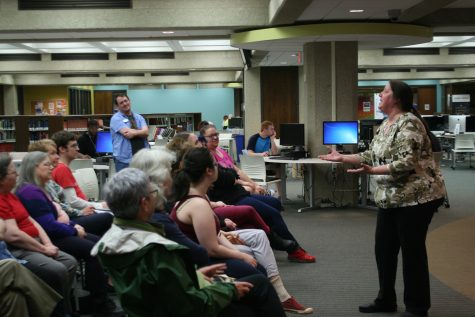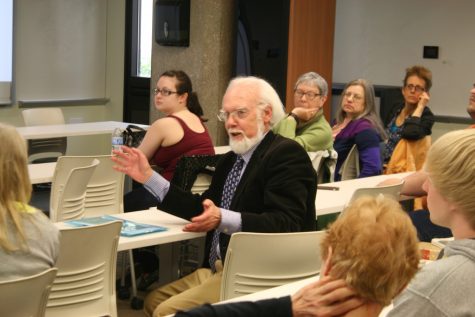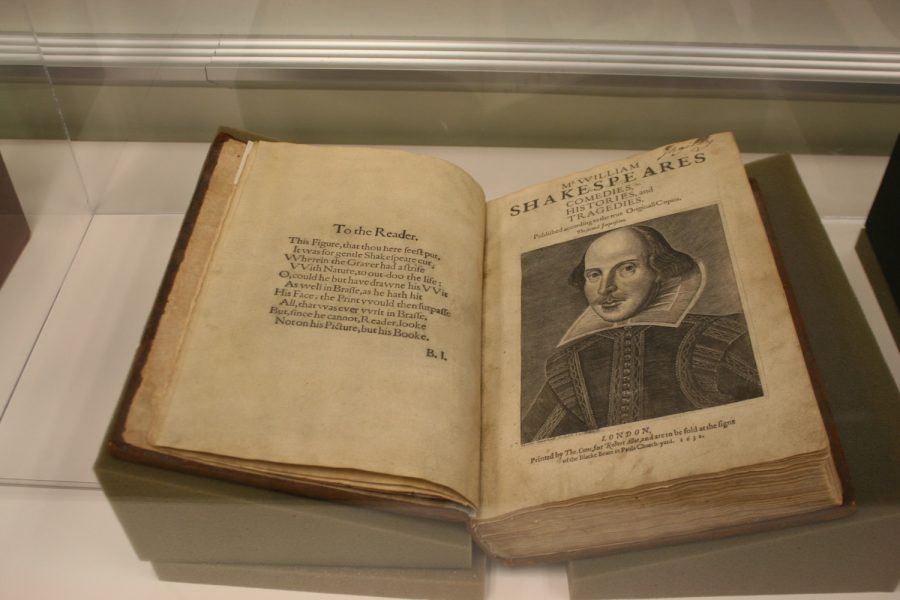The Sweet Swan of Avon; alive on the day of his death
This 384-year-old book, UA archives’ original copy of Shakespeare’s second folio, was displayed at last Friday’s event celebrating the playwright’s life and work.
April 25, 2016
William Shakespeare was quite alive last week when The University of Akron celebrated the 400th anniversary of his death.
Last Friday, April 22, UA’s English and Archival Services departments teamed up to host an afternoon of all things Shakespeare and his works, which included two presentations, a gallery of some 17th-century collections of the Bard’s plays, and diverse performances by actresses from Akron’s Rubber City Shakespeare Company.

Rubber City Shakespeare Company actress Michele McNeal recites a soliloquy to the crowd in Bierce Library.
Archival Services’ display of early copies of Shakespeare folios (large, expensive books with many plays printed) and quartos (small, handheld books with usually only one or two plays) were the event’s main attraction.
There were four folios of Shakespeare’s works printed in the 1600s: the first in 1623, which is commonly known to be the most studied book besides the Bible; the second in 1632; the third in 1664; and the fourth in 1685. UA’s archives have copies of the latter three, which were displayed to the public on Friday.
“I was thinking about how many places these books have been, how many people have touched them and read them from 400 years ago, or 300 years ago, or even 150 years ago,” said Michele McNeal, one of the Rubber City Shakespeare actors who attended. “Someone was probably reading that during the Revolutionary War. It probably sat on their shelf next to the Bible and Ovid, or maybe Aristotle.”
The books were donated to UA by Akron business magnate Herman Muehlstein (1880-1962), whose rubber and plastics company still exists, and whose library now makes up the UA archives’ most distinguished collection of rare books. Besides Shakespeare, some of the collection’s other books include first editions of Walt Whitman’s “Leaves of Grass,” Mark Twain’s “Adventures of Huckleberry Finn,” Stephen Crane’s “The Red Badge of Courage,” and even a 1466 copy of “Cicero” by Johannes Fust.
William Williams, a Shakespeare scholar and former UA professor, says the third folio is the rarest because most of them were burned up by the Great Fire of London in 1666. He also said it is the most peculiar because of the seven extra plays it has that were not included in the second folio, whose titles appear in big letters on the first page.

Shakespeare scholar and former UA professor William Williams enlightens the audience on the playwright’s folios during the first presentation of Friday afternoon.
“Notice they don’t say that [the seven extra plays] are by Shakespeare,” Williams said with a laugh, “they just say they’ve never been printed in folio before.”
Only one of those plays, it turns out, was authored by Shakespeare (“Pericles”). But because each new folio was basically a reprint of its predecessor, these fraudulent plays stayed in the collection for the fourth folio.
Two other Shakespeare quartos were also on display, both of which were printed in 1619. One might have been surprised, then, to see on their title pages that the first was printed in 1600 and the other in 1608.
“Back then, copyright was real property, and [the quartos’ publishers] couldn’t buy the copyright of the plays off the people who owned them,” Williams said. “So they printed these, put false dates on them; and so long as everyone thought they were earlier quartos, everything was fine.”
Taylor Marshall, a UA senior and English major who works in Archival Services, says she sees the books often.
“It’s nice for the archives to get recognized because few people know a whole lot about us,” Marshall said. “And I think it’s great for people to come out and appreciate Shakespeare and history through books.”
Junior biology major Taylor Thompson also attended, saying he was surprised the books were in such pristine condition for being almost 400 years old.
The reason for the books’ endurance is the quality of their materials. Instead of the wood pulp-based, acid-filled paper common today, the Shakespeare folio paper was rag paper made from linen. This paper is strong and can last for hundreds of years without fading, discoloration, or degeneration.
Also at the event, which in total brought in around 50 to 60 people, was Cleveland Digital Public Library strategist Chatham Ewing. In the second presentation of the afternoon, he talked about the Cleveland Library’s upcoming “Summer of Shakespeare,” whose galleries and exhibits opened on April 23 and will be on display until December.
One of those exhibits will include an original copy of Shakespeare’s first folio, the only such exhibit in Ohio. More information about the events can be found here: goo.gl/CwF9vr.
UA’s Archival Services is located in the Polsky Building in room LL10. Its hours are 8 a.m. to 5 p.m. Monday through Friday. Along with everything in the Muehlstein rare book collection, visitors can see artifacts and books on everything from the University itself to the history of Akron and its rubber industry roots. More information can be found at uakron.edu/libraries/archives/.












